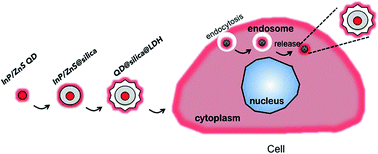Increasing cell viability using Cd-free – InP/ZnS@silica@layered double hydroxide – materials for biological labeling†
Abstract
In this work we describe the synthesis and characterization of InP/ZnS@silica@LDH nanoparticles and, moreover, their use as biomarkers. The use of dual systems combining silica shells and hydrotalcite nanocoatings favors the cell viability in clear contrast with the system with only silica shells. Furthermore, the use of Cd-free luminophores extends the cells lifetime and illustrates the potential of the InP/ZnS@silica@LDH material as a biomarker.


 Please wait while we load your content...
Please wait while we load your content...